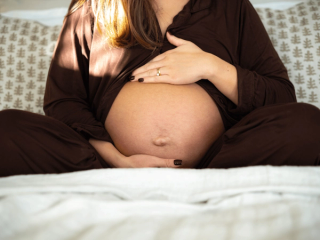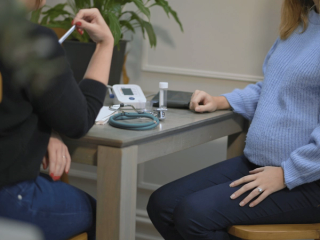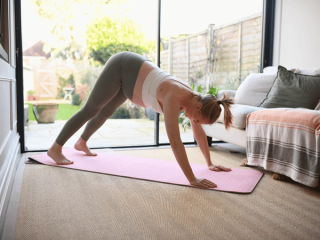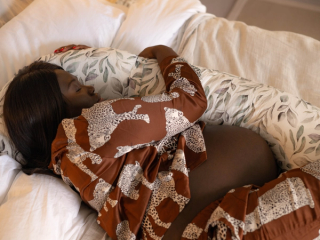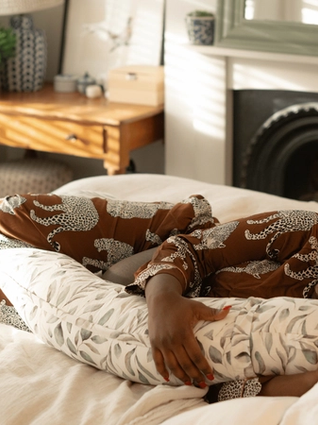
- Home
- Advice Hub
- Pregnancy
- Pregnancy Care
- Pregnancy Pillow Guide
Pregnancy pillow: What is it? How to use it and are they worth it?
Find out what a pregnancy pillow is and how it can help support you and your baby bump throughout your pregnancy.
What is a pregnancy pillow?
How to choose a pregnancy pillow
Types of breastfeeding pillow
Total body pillows and full-length body pillows
Fabric choices for breastfeeding pillows
Price
How to use a pregnancy pillow
What is side sleeping?
Why is side sleeping beneficial?
How can a pregnancy pillow help with side sleeping?
Pregnancy Pillow FAQs
Reviewed by Christine Lane, Midwife and Consultant, on the 24.09.2025
One piece of advice many expectant parents hear is: “Rest while you can – you won’t get any sleep once the baby arrives!” While well-meaning, it can feel a little frustrating – especially when getting quality sleep during pregnancy is often easier said than done. For many, it’s a time of growing discomfort and disrupted rest. That’s where pregnancy pillows can really help.
What is a pregnancy pillow?
Pregnancy pillows are specially designed cushions shaped to support your changing body as your pregnancy progresses. They come in a range of shapes, sizes and materials, so you should be able to find one that suits you.
Do I need a pregnancy pillow?
If you think about the shape of your body now compared to pre-pregnancy, it’s easy to see why you might be getting a lot of aches and pains. Your growing baby (plus amniotic fluid, plus placenta) is putting a lot of pressure on your back. During the day, this will impact the way you stand, walk and sit.
At night, as you lay on your side, the weight of your bump can cause discomfort in your back, hips and legs. Pregnancy pillows are designed to be comfortable and supportive, cushioning your bump and your back. They can make a world of difference to how well you sleep and give you the energy you need to get through the next day.
That being said, a pregnancy pillow is not an essential. You can achieve a similar effect by arranging ordinary pillows to support your back and bump – though you might find they don’t stay in place all night long.
Are pregnancy pillows worth it?
Our HiPP mums report different degrees of usefulness from the pregnancy pillows, with some saying they couldn’t have managed without, while others didn’t get on with them. Clearly, it’s a personal preference and there is no universal answer on which pillow is best, or which will guarantee you good value for money. For this reason, it’s a good idea to ask among friends or relatives if anyone has a pregnancy pillow you could borrow – at least in the first instance. This gives you the opportunity to try before you buy.
If you do find the pregnancy pillow helpful, however, it’s certainly a worthwhile investment to see you through many months of discomfort. Getting a good night’s sleep is an important part of preparing yourself to give birth and care for a baby, not to mention to help get you through all the days before that. Some even suggest that by helping you find a comfortable position to sleep in through your third trimester, pregnancy pillows help the baby get themselves into a good position for labour.
How to choose a pregnancy pillow
Pregnancy pillows come in different shapes and sizes. Consider:
- The length of the pillow in relation to your height
- The support offered in relation to your sore spots
- The size of the pillow compared to the size of your bed (and whether or not your partner will fit in too!)
- How easy the pillow and pillowcase are to wash
- Whether you want to be able to use it to support breastfeeding after the baby is born
Types of breastfeeding pillow
Wedge pillows
Wedge pillows are the smallest type of pregnancy pillow, taking up the least amount of room in your bed. Shaped like a triangle, you put the narrowest end underneath your bump to support you while you sleep. Wedge pregnancy pillows are a good option for smaller beds and for those who don’t move around a lot while they sleep.
Another option for those liable to toss and turn through the night is wearable sleep support. HiPP family, Ian and Faye, recommend the Babymoov Dream Belt, which you attach around your bump for comfortable support through the night. ‘I used it in combination with a U-shaped pregnancy pillow – essential as I had pelvic girdle pain,’ says Faye.
Total body pillows and full-length body pillows
HiPP dad Scott describes his partner’s pregnancy pillow as a ‘large, snake-like thing’. Scott is likely describing a C-shaped body pillow, designed to provide full-body support.
Body pillows also come in a U-shape design, supporting your neck, back, and bump, with the option to place part of the pillow between your knees for extra comfort. While the C-shape design offers support on one side, U-shaped pillows provide cushioning on both sides, making it easier to switch from left to right during the night without needing to adjust the pillow.
HiPP mum Gen recommends ‘the total U shaped one, not the half U-shaped one,’ adding: ‘It’s also really helpful to use after the baby’s born, as a breastfeeding pillow, and as a donut cushion after the birth if you are too sore to sit comfortably’.
Full-length body pillows are straight – like a regular pillow but much longer.
Fabric choices for breastfeeding pillows
If you find yourself getting hot and sweaty at night, it’s also important to think about what fabric your pregnancy pillow is made from. Organic cotton is more likely to help you stay cool than synthetic materials. Bamboo is a good alternative. In either case, make sure the pillowcase comes off (easily!), as you don’t want to harbour any nasty bacteria in your bed. All pregnancy pillows should be machine washable but check the label for manufacturer’s instructions.
Price
How much you spend on a pregnancy pillow will depend on your personal budget. If you're planning to use it for more than one pregnancy, or feel it’s worth the investment, it might make sense to spend a little more on one that really suits your needs. But if money’s tight, don’t worry – many people find comfort by using a few regular pillows and arranging them in a way that supports their body. It’s all about finding what works best for you.
We recommend taking a look at BellaMoon, who is one of our BabyClub Partners . BellaMoon is a pregnancy, breastfeeding and attachment parenting brand, specialising in pregnancy pillows, nursing and rest systems. Plus, if you join our free BabyClub , you can get an exclusive discount to use on BellaMoon’s website!
Buying second-hand
As you’ll notice from online reviews, many people buy pregnancy pillows that they don’t get on with. That means that there are nearly new pregnancy pillows available to buy second-hand. You have to be comfortable with this, and it is advisable to wash the full pillow and not just the cover, should you buy a used pregnancy pillow.
However, you might find your local nearly new sale is a great way of finding the right pillow for you at a price you can afford – not to mention giving you the opportunity to stock up on other things you need for your new arrival.
How to use a pregnancy pillow
U- and C-shaped pregnancy pillows are flexible enough to use as you like. Pull the pillow around you in the way that feels most comfortable, remembering to support under your bump and between your knees to give your back a break. Pregnancy pillows are designed for side sleeping, which is the recommended sleeping position throughout the third trimester.
What is side sleeping?
Side sleeping is simply sleeping on your side. You can sleep on your left or right side during pregnancy, though left is sometimes thought to help with digestion and may ease symptoms like heartburn and indigestion.
From around the end of your second trimester, it’s recommended to sleep on your side – either left or right – as this is considered safer for your baby. As your bump grows, you’ll probably find side sleeping more comfortable too, since lying on your back can put pressure on internal organs and reduce blood flow. Stomach sleeping usually stops being comfortable quite early in pregnancy.
Why is side sleeping beneficial?
Sleeping on your side helps support healthy blood flow through a major artery that runs along your spine, which supplies oxygen to the placenta. This is one of the main reasons why side sleeping is recommended during the later stages of pregnancy. Lying flat on your back can sometimes press on this artery, which may reduce blood flow – so side sleeping is a simple way to help keep things comfortable and safe for both you and your baby.
Research has shown that the position you fall asleep in is the one you stay in for the longest, so falling asleep on your side is important. If you wake up on your back, don’t worry. Just roll back on to your side to go back to sleep.
How can a pregnancy pillow help with side sleeping?
Pregnancy pillows help you sleep on your side by providing a comfortable ‘nest’ to fall asleep in. When you’re sleeping comfortably, you’re less likely to move around. And if you use a U-shaped pillow, you will likely find the pillow at your back prevents you from rolling onto your back in the night.
Pregnancy Pillow FAQs
Yes, pregnancy pillows can help prevent back pain by giving you a more comfortable night sleep. Supporting your bump prevents strain on your back, while a pillow between your knees eases lower back, hip and knee pain.
Yes, pregnancy pillows help side sleeping by providing support along both your front and back. With a pillow under your bump and between your legs, a side sleeping position is the most comfortable pregnancy sleeping position.
It is not recommended to sleep on your back once you’re past your second trimester. If you’re finding it difficult to sleep on your side, a pregnancy pillow positioned at your back can help stop you rolling onto your back in the night.
Pregnancy pillows are not associated with birth defects. Birth defects sometimes correlate with genetic factors, or behaviours such as smoking or drinking during pregnancy. Often, it’s not possible to say why a birth defect occurred.
Yes, pregnancy pillows are washable, and you should wash them. Keep the pillowcase fresh by washing regularly, and wash and air the pillow itself from time to time.
Some pregnancy pillows double up as breastfeeding pillows. For example, you could wrap a C-shaped pillow around you to rest your arm on while feeding, giving the baby a bit more height to bring them closer to your breast. For babies that feed for a long time, it’s useful to have something to rest on! Breastfeeding pillows can also ease back pain and tension in your shoulders.
